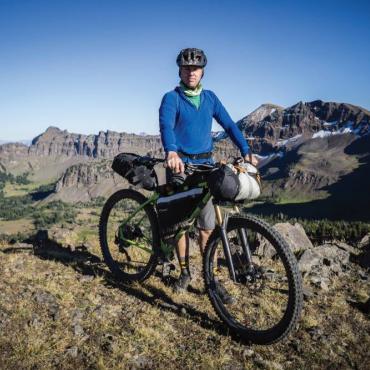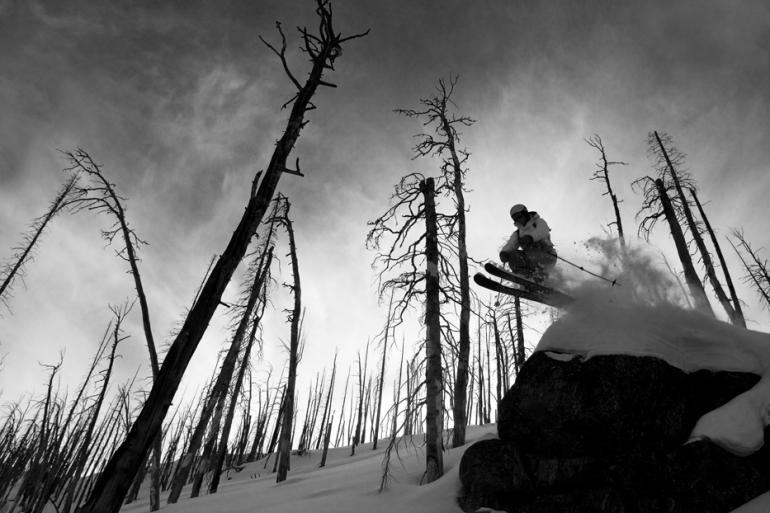Feeling the Burn
Skiing in a foreign landscape.
The forest, once too thick to ski through, had thinned and opened itself up, granting us the opportunity to explore its altered terrain. Standing on top of the ridgeline, we look down at the burn, toward the ruins and all of the subsequent hillsides that fell victim to the fire. Countless Lodgepole Pine, Douglas Fir, and Alpine Fir were left charred and unrecognizable. It is a massive forest graveyard. Soon we will walk among the remains and slide down through the forest, carving turns on the unmarked hillsides.
The Bostwick Fire started down low in the canyon on a fall afternoon in 1991. Warm weather during the week and a heavy wind that day allowed the blaze to spread, and by late afternoon the fire reached the ridgeline and took off down the east side into the Slushmann’s drainage.
The heavy winds and spreading fire posed a significant threat, and during that first day, mandatory evacuation of Bridger Canyon to the north of Olson Creek began as the crew continued to fight the fire. By midnight, it was able to contain the largest spot of fire on the eastern side of the range and reduce the threat to the ski area and the homes of the canyon.
Almost two decades later, I stand on top of that ridgeline as the same wind blows up the canyon and sweeps violently over the top. With my skis strapped securely, I swing my pack up and onto my back, cinch the straps, and take off to the south. I head up the ridge one step at a time, each matched by an opposing pole plant.
Working my way up the bootpack, a strong wind attacks me from my right side. The heavy gusts cause me to lose my breath. I feel starved of oxygen, and my lungs burn while the fierce wind whips past my face. Continuing on, my mind wanders, and I think about that October afternoon when that same wind tore across the ridgeline and brought fire up from low in the canyon. I think about being inside the blaze, how the smoke would fill my lungs and leave me gasping for oxygen. An intense heat would engulf the area, eliminating anything in its path. The crisp, cold air chills me through my winter shell.
At the peak of the burn, the Bostwick Fire drew nearly 500 people working to suppress the blaze and contain the surrounding area. The fire burned for over a month, charring more than 1,000 acres and causing $750,000 in damage. The potential threat of the fire was huge, but if asked, many people living in Bozeman today would not know about the Bostwick Fire.
I am no different. If I had not walked across that ridgeline and looked in the distance in search of the perfect place to ski, I too would not have known. It wasn't a large-scale fire compared to some, but it's enough of a reminder that the forces of nature are unforgiving and can strike at any time.
We reach the top. We pause one final time in our harsh environment before taking off down the west side and along the outer edge of the burn. The colors of the neighboring lush forest quickly fade to black as we travel, and all at once we are in a completely foreign environment.
As we continue to skin through the burnt surroundings, each tree moves by our side one by one. It feels like something from a dream. There is a stark contrast between the desaturated forest and the fresh blanket of snow it's reaching through; the scene is unmatched for its visual appeal. The charred remains have weathered away through time, and only a few unique shapes among the thousands of black toothpicks remain.
Finally at our destination, we point our skis toward the landscape below and float down through the white, flawless hillsides with speed and ease while the black, eerie, remains fly by our sides in a blur, like a charcoal painting. We reach the bottom of our last run and look back up at the burn, toward the tracks that stand alone as a road map detailing our time here.
Spending a day in the burn is like spending a day in another part of the world. This is not the Bridger Range that we're accustomed to. It's not the vast, open bowls of the resort, the steep, vertical lines to the north, or even the tight, technical areas on the ridge. It is like nothing else.
Hours later, as the light begins to fade in the Gallatin Valley and the alpenglow from the late-day sun accentuates the western face of the Bridgers, the wind begins to pick up again. As it blows through the gaps in the black forest and makes its way up to the ridgeline, it carries snow and begins to cover our tracks.
Our experience in this territory is fleeting, and just as our tracks will fade, so too will the burn. And the narrow window of time we have to visit such a place will have come and gone. By the time the sun rises in the east and the lifts start up at Bridger Bowl, any indication of our assault will be erased. As if it never happened.










